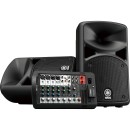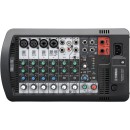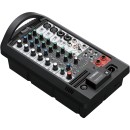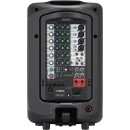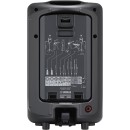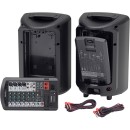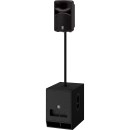Yamaha STAGEPAS 400BT Portable 8-Channel PA System Review
- 8-Channel Mixer: Offers versatile connectivity options including microphones, instruments, and line-level devices.
- Bluetooth Connectivity: Allows for wireless streaming of music from smartphones, tablets, and other Bluetooth-enabled devices.
- 400 Watts of Power: Delivers robust sound suitable for small to medium-sized venues.
- High-Quality Sound: Features Yamaha’s advanced DSP technology for clear and natural sound reproduction.
- Reverb Effects: Includes four types of reverb effects to enhance vocal and instrumental performances.
- Feedback Suppressor: Automatically detects and reduces feedback for a smoother sound experience.
- Portable Design: Lightweight and easy to transport, making it ideal for mobile performances.
- Built-in 1-Knob Master EQ™: Simplifies sound adjustment to suit various environments and applications.
- Detachable Mixer: Can be removed from the speaker for easy access and flexibility in positioning.
Detailed Specifications and Insights
The Yamaha STAGEPAS 400BT is a versatile and portable 8-channel PA system designed for ease of use and powerful performance. Ideal for a variety of settings, from small gigs and events to rehearsals and presentations, this system offers a comprehensive solution for audio amplification needs. Its compact design allows for quick setup and transportation, making it perfect for performers and presenters on the go.
This PA system includes a 400-watt powered mixer and a pair of high-quality speakers, delivering clear and robust sound. With its integrated Bluetooth functionality, users can conveniently stream music wirelessly from their devices, adding flexibility to its operation. The mixer features a range of inputs, including XLR, line-level, and stereo inputs, providing ample connectivity options for microphones, instruments, and other audio sources.
The Yamaha STAGEPAS 400BT also includes a suite of built-in effects, such as reverb and EQ, allowing users to shape their sound to suit different environments and preferences. The system's intuitive controls ensure that even users with minimal technical expertise can achieve professional results. Overall, the Yamaha STAGEPAS 400BT is a reliable and efficient choice for anyone in need of a portable PA solution with advanced features and straightforward operation.
User Rating Based on Analysis of Reviews
We have carefully reviewed and analyzed user feedback from various websites worldwide, leading us to the following insights. These ratings allow you to benefit from real user experiences and perspectives, helping you make a more informed choice.
Purchase Value
85% of users appreciated the purchase value of the Yamaha STAGEPAS 400BT, emphasizing the system's excellent balance between cost and functionality. Many mentioned that the sound quality and portability offered at this price point were unexpected bonuses, making it a worthwhile investment for small to medium-sized events.
15% of users were dissatisfied with the purchase value, mainly because they felt there were comparable systems available at lower prices. Some also noted that the system lacked certain features, like built-in effects, which they expected given the price.
Sound Quality
90% of users praised the sound quality, noting that the system provided clear, crisp audio suitable for various venues. The bass response and overall volume capacity were frequently highlighted as being particularly impressive for a compact system, making it ideal for live performances and events.
10% of users expressed dissatisfaction with the sound quality, stating that the system struggled in larger venues where higher volumes were required. Some users also experienced distortion at higher volumes, which limited the system's effectiveness for certain events.
Portability
95% of users were delighted with the system's portability, highlighting its lightweight design and ease of transportation. This made it particularly appealing for mobile DJs and event organizers who require quick setup and teardown times without compromising on sound quality.
5% of users were dissatisfied with the portability, mainly due to the lack of wheels or a trolley system for easier transport. A few users also mentioned that the speaker stands were somewhat cumbersome to carry along with the system.
Ease of Use
88% of users found the Yamaha STAGEPAS 400BT easy to use, appreciating its intuitive control panel and straightforward setup process. The Bluetooth connectivity was often cited as a convenient feature, allowing for quick streaming from devices without any complex configuration.
12% of users found the system somewhat challenging to use, particularly those unfamiliar with PA systems. Some users reported that the control panel lacked detailed instructions, which made initial setup more difficult than anticipated.
Bluetooth Connectivity
80% of users were satisfied with the Bluetooth connectivity, noting that it worked seamlessly for streaming music and provided good range and reliability. This feature was particularly appreciated by those who needed to play music from mobile devices without using cables.
20% of users were dissatisfied with the Bluetooth feature, citing occasional connectivity issues and dropouts during performances. Some users also felt that the range was limited, requiring them to stay close to the system to maintain a stable connection.
Durability
87% of users were satisfied with the system's durability, mentioning that it withstood the rigors of frequent transport and use. The build quality was often described as robust, with materials that seemed capable of enduring various environmental conditions.
13% of users experienced issues with durability, reporting cases of physical damage or component failures after short periods of use. Some users expressed concerns about the plastic construction, fearing it might not hold up over time with regular use.
Versatility
86% of users appreciated the system's versatility, noting its suitability for a wide range of events from small parties to larger gatherings. The multiple input options and adjustable sound settings allowed users to tailor the system to different needs effectively.
14% of users were dissatisfied with the versatility, pointing out limitations in handling larger events or more complex setups. Some users felt the system lacked sufficient input or output options for their specific requirements.
Mixer Features
82% of users were pleased with the mixer features, appreciating the simplicity and effectiveness of the built-in controls and effects. The ability to adjust sound levels and EQ settings on the fly was frequently noted as a significant advantage.
18% of users found the mixer features lacking, particularly in terms of more advanced options that they expected for professional use. Some felt the effects were too basic and desired more control over sound shaping.
Customer Support
78% of users were satisfied with Yamaha's customer support, noting that representatives were generally helpful and responsive to inquiries. Warranty services were also mentioned positively by those who required replacements or repairs.
22% of users were dissatisfied with customer support, citing delays in response times and difficulties in resolving issues. Some users felt that support staff lacked the necessary expertise to address technical problems effectively.
User Documentation
75% of users found the user documentation to be adequate, providing enough information for basic setup and operation. Many appreciated the clear instructions and diagrams that facilitated their understanding of the system.
25% of users were dissatisfied with the user documentation, criticizing it for being too simplistic and lacking in detail. Some users expressed frustration in finding specific information on troubleshooting or advanced features.
Design
85% of users appreciated the sleek and professional design of the Yamaha STAGEPAS 400BT, noting that it looked great in both casual and formal settings. The compact size was also seen as a design strength, allowing for easy placement in various environments.
15% of users were dissatisfied with the design, feeling that it lacked certain aesthetic elements or color options. A few users also mentioned that the mixer layout could be more ergonomic for easier access during performances.
Power Output
88% of users were satisfied with the power output, stating that the system provided more than enough volume for small to medium-sized venues. The ability to maintain clarity even at higher volumes was often praised by event organizers and performers.
12% of users were dissatisfied with the power output, particularly those who needed to cover larger spaces. Some users felt that the system reached its limits too quickly and lacked the punch required for bigger events.
Setup Time
92% of users were impressed with the quick setup time, noting that the system could be assembled and ready to use in a matter of minutes. The intuitive design and minimal cabling were frequently mentioned as contributing factors to the efficient setup process.
8% of users found the setup time to be longer than expected, often due to unfamiliarity with the system or issues with connectivity. Some users desired more guidance during the initial setup to streamline the process.
Feedback Control
80% of users were satisfied with the feedback control features, mentioning that the system effectively minimized unwanted noise and feedback during performances. This was particularly appreciated in live music settings where feedback can be a persistent issue.
20% of users experienced issues with feedback control, noting that the system occasionally failed to suppress feedback in challenging acoustic environments. Some users desired more advanced feedback suppression features.
Serviceability
77% of users felt that the system was serviceable, with accessible components that made repairs and maintenance straightforward. The availability of replacement parts was also seen as a positive factor for long-term usability.
23% of users were dissatisfied with the serviceability, citing difficulties in obtaining parts or finding service centers. Some users felt that the internal components were too complex for DIY repairs, requiring professional assistance.
Weight
90% of users were satisfied with the weight of the system, highlighting its lightness as a major benefit for transportation and handling. This was particularly important for users who needed to move the system frequently for different events.
10% of users were dissatisfied with the weight, primarily those who expected an even lighter design for ultra-portability. Some users also mentioned that the weight distribution was uneven, making it awkward to carry.
Input Options
83% of users were satisfied with the variety of input options, mentioning that the system could accommodate various devices and instruments easily. The multiple channels allowed for flexibility in configuring different audio sources.
17% of users were dissatisfied with the input options, feeling that the system lacked certain inputs they needed for specific equipment. Some users desired more XLR or line inputs for additional versatility.
Output Options
82% of users appreciated the output options available, noting that the system could connect to additional speakers or audio equipment without difficulty. This was especially useful for those looking to expand their setup.
18% of users found the output options to be lacking, particularly those who needed more flexibility for complex audio setups. Some users desired additional outputs for connecting to larger sound systems.
Value for Money
85% of users believed the Yamaha STAGEPAS 400BT offered great value for money, given its features, sound quality, and build. Many users felt that the investment was justified by the system's performance and reliability.
15% of users were dissatisfied with the value for money, feeling that the system was overpriced for the features offered. Some users compared it unfavorably to other systems in the same price range that included more advanced options.
Longevity
86% of users were satisfied with the system's longevity, mentioning that it continued to perform well over time without significant degradation in quality. This reliability was a key factor for users who needed a dependable PA system.
14% of users were dissatisfied with the longevity, experiencing issues such as component failures or reduced performance after extended use. Some users felt that certain parts of the system were prone to wear and required frequent maintenance.
Aesthetic Appeal
84% of users found the system aesthetically appealing, appreciating its sleek, modern look that fit well in various settings. The professional appearance was often mentioned as a positive aspect that enhanced their events.
16% of users were dissatisfied with the aesthetic appeal, some feeling that the design was too basic or lacked customization options. A few users desired more color choices or design variations to suit their personal style preferences.
In the following sections, we will delve into the specifications, advantages, and disadvantages of the Yamaha STAGEPAS 400BT Portable 8-Channel PA System. This comprehensive review aims to provide you with all the necessary information to evaluate this product thoroughly.
Pros:
- Compact and portable design makes it easy to transport and set up.
- Built-in Bluetooth capability allows for wireless audio streaming.
- 8-channel mixer provides flexibility for various audio inputs.
- High-quality sound output suitable for small to medium-sized venues.
- User-friendly interface with intuitive controls.
Cons:
- Limited power output may not be suitable for very large venues.
- Lack of advanced features compared to higher-end PA systems.
- May require additional accessories or equipment for certain setups.
- Bluetooth range might be limited in certain environments.
- Priced higher than some entry-level PA systems.
Portable PA System
| Speaker Configuration | 2x 2-Way Loudspeaker |
|---|---|
| Number of Input Channels | 8 |
| Amplifier Power Rating | 400 W Peak (at 4 Ohms) 360 W RMS (at 4 Ohms) |
Speaker Configuration: The Yamaha STAGEPAS 400BT features a configuration of 2x 2-Way Loudspeakers. This means that each speaker is designed to handle a range of frequencies effectively, with dedicated drivers for both low (woofer) and high (tweeter) sounds. This configuration provides a balanced audio output, ensuring that vocals and instrumentals are clear and distinct, making it ideal for various applications, from live performances to public speaking events.Show More
Number of Input Channels: With 8 input channels, this PA system allows users to connect multiple audio sources simultaneously. This flexibility is particularly beneficial for events that require several microphones, instruments, or other audio equipment. The ability to mix different audio signals enhances the overall sound experience and caters to diverse performance needs, making it suitable for both small gigs and larger gatherings.
Amplifier Power Rating: The amplifier power rating of 400 W Peak and 360 W RMS at 4 Ohms signifies the system's capability to deliver robust sound output. The peak power indicates the maximum power the amplifier can handle for short bursts, which is essential for dynamic sounds, while the RMS (Root Mean Square) rating reflects the continuous power output the system can sustain without distortion. This level of power ensures that the system can fill larger spaces with sound, providing a clear and powerful audio experience for audiences.
Speakers
| Enclosure Type | Bass-Reflex |
|---|---|
| HF Driver | 1" / 25.4 mm Compression Driver |
| HF Voice Coil | 1" / 2.54 cm |
| LF Driver | 8" / 20 cm Woofer |
Enclosure Type: The Yamaha STAGEPAS 400BT features a Bass-Reflex enclosure design. This type of enclosure is engineered to enhance the bass response by allowing air to escape from the rear of the speaker cabinet. The design effectively increases the efficiency of the low-frequency reproduction, resulting in deeper and more powerful bass sounds. This is particularly beneficial for live performances and events where impactful sound is essential.Show More
HF Driver: The system is equipped with a 1" (25.4 mm) compression driver. Compression drivers are known for their ability to handle high power levels while providing clear and detailed high-frequency sound. This driver size strikes a balance between efficiency and sound quality, making it suitable for various applications, from speeches to musical performances, ensuring that high frequencies are reproduced accurately and with minimal distortion.
HF Voice Coil: The STAGEPAS 400BT features a 1" (2.54 cm) HF voice coil. The voice coil is a crucial component that converts electrical signals into sound. A larger voice coil can handle more power and provide better thermal management, which translates to improved performance and durability. The 1" size indicates a good balance of power handling and sound quality, making it ideal for delivering clear vocals and crisp high notes.
LF Driver: The system includes an 8" (20 cm) woofer as its low-frequency driver. The size of the woofer influences the speaker's ability to produce deep bass sounds. An 8" woofer is capable of delivering a rich low-end response, making it suitable for various genres of music and speech applications. This size is effective in providing a solid foundation for the overall sound output, enhancing the listening experience in both small and medium-sized venues.
Signal Processing
| EQ | LF Shelf at 100 Hz |
|---|---|
| Effects | Reverb |
The EQ feature, specifically the LF Shelf at 100 Hz, refers to the equalization capabilities of the Yamaha STAGEPAS 400BT. This setting allows users to adjust the low-frequency response of the audio output, emphasizing or de-emphasizing sounds below 100 Hz. By manipulating this frequency, users can enhance the warmth and fullness of music or speech, making it particularly useful for live performances where bass tones can significantly impact sound quality. A well-tuned low-frequency shelf can help create a balanced sound that resonates well with the audience.Show More
When it comes to Effects, the inclusion of Reverb adds depth and richness to the sound output. Reverb simulates the natural echo that occurs in various environments, allowing the audio to feel more immersive and engaging. This effect is essential for enhancing vocals and instruments, giving them a sense of space and presence. The ability to adjust reverb levels can greatly influence the overall atmosphere of a performance, making it feel more professional and polished, whether in a small venue or a larger setting.
Performance
| Frequency Range | 55 Hz to 20 kHz -10 dB |
|---|---|
| Maximum SPL | 125 dB SPL |
| Coverage Angle | 90° H x 60° V |
The Frequency Range of the Yamaha STAGEPAS 400BT is specified as 55 Hz to 20 kHz at -10 dB. This range indicates the lowest and highest frequencies the system can reproduce effectively. A lower frequency limit of 55 Hz allows for rich bass sounds, enhancing the overall audio experience, while the upper limit of 20 kHz ensures clarity and detail in high-frequency sounds, such as vocals and instruments. This broad frequency range is essential for delivering a balanced and full sound across various types of audio content.Show More
The Maximum SPL (Sound Pressure Level) of 125 dB SPL reflects the loudest sound output the system can produce without distortion. This measurement is crucial for live events or situations where high volume is required, such as concerts or public speaking engagements. A higher SPL means the system can fill larger spaces with sound, making it suitable for both intimate gatherings and larger venues, ensuring that the audio remains clear and powerful even at elevated levels.
The Coverage Angle of 90° horizontally and 60° vertically indicates the dispersion pattern of the sound produced by the speakers. A wider horizontal coverage means that sound can reach a broader audience area, which is particularly beneficial in venues where people are seated in various positions. The vertical coverage angle ensures that sound reaches both the front and back of the audience effectively. This characteristic is essential for creating an immersive audio experience, allowing more people to enjoy consistent sound quality regardless of their location in the venue.
Connectivity
| Audio I/O | 2x XLR 3-Pin Mic/Line Input 1x Combo XLR-1/4" TRS Mic/Line Input 1x Combo XLR-1/4" TRS Mic/Line/Hi-Z Input 4x 1/4" TRS Line Input 1x Stereo RCA Coaxial Line Input 1x 1/8" / 3.5 mm TRS Line Input 2x 1/4" TS Speaker Output 2x 1/4" TRS Monitor Output 1x 1/4" TRS Subwoofer Output 1x 1/4" TRS Footswitch Input |
|---|---|
| Phantom Power | +30 V |
| Wireless Connectivity | Bluetooth |
| Max Wireless Range | Bluetooth: 32.8' / 10 m |
| Bluetooth | 4.1 |
| Bluetooth Profiles | A2DP 1.2 |
The Audio I/O section outlines the various input and output options available on the Yamaha STAGEPAS 400BT. This portable PA system features a diverse range of connectivity, including multiple XLR and TRS inputs for microphones and instruments, as well as line inputs for connecting additional audio sources. The inclusion of both mono and stereo inputs allows for flexible configuration, catering to different performance needs. The presence of outputs for speakers, monitors, and a subwoofer ensures that the audio can be distributed effectively across different setups.Show More
The Phantom Power feature indicates that the system provides +30 V of phantom power, which is essential for powering condenser microphones. This is particularly useful in live sound situations where high-quality vocal capture is required. Having phantom power available allows users to connect a wider variety of professional microphones without needing additional equipment, simplifying setup and enhancing audio quality.
In terms of Wireless Connectivity, the Yamaha STAGEPAS 400BT supports Bluetooth for easy audio streaming from compatible devices. With a maximum wireless range of 32.8 feet (10 meters) and Bluetooth version 4.1, users can enjoy the convenience of wireless sound input without being tethered to the system. The supported Bluetooth profiles, including A2DP 1.2, ensure high-quality audio streaming, making it an excellent choice for performances where a clean and reliable wireless connection is essential.
Power
| AC Input Power | 100 to 240 VAC, 50 / 60 Hz |
|---|---|
| Power Consumption | 30 W (Idle) 70 W (1/8 Power) |
| AC Power I/O | IEC |
The AC Input Power specification indicates the voltage range and frequency that the Yamaha STAGEPAS 400BT can operate on. With an input power range of 100 to 240 VAC and a frequency of 50/60 Hz, this portable PA system is designed to function in a wide variety of global power environments. This versatility makes it suitable for users traveling internationally or using it in different locations without worrying about power compatibility.Show More
Power Consumption is another important specification, detailing how much electrical power the system consumes during operation. At idle, the system consumes 30 W, which means it can run efficiently without drawing too much power when not in active use. When playing audio at 1/8 power, the consumption increases to 70 W. Understanding these consumption levels is crucial for users who want to manage energy use effectively, especially for long events or in locations where power supply may be limited.
The AC Power I/O specification refers to the type of power connector used by the system. The IEC connector is a standard in audio equipment, ensuring a secure and reliable connection to power sources. This feature allows users to easily find compatible power cables and ensures that the system can be connected safely and efficiently in various settings.
Physical
| Transport Options | Handle (Top) |
|---|---|
| Mounting | 1.4" / 35 mm Pole Socket |
| Environmental Protection | |
| Dimensions | Speaker: 11.4 x 18.6 x 10.8" / 28.9 x 47.2 x 27.5 cm Mixer: 12.1 x 7.1 x 4.6" / 30.8 x 18 x 11.6 cm |
| Weight | 40.3 lb / 18.3 kg |
Transport Options: The Yamaha STAGEPAS 400BT features a top handle that enhances portability. This design makes it easier for users to carry the system to different venues, whether it's for a gig, a presentation, or any outdoor event. The convenience of a handle allows for quick setup and teardown, making it ideal for mobile performers and speakers.Show More
Mounting: The system includes a 1.4" / 35 mm pole socket, which provides flexibility for mounting the speakers on stands. This feature is essential for achieving optimal sound dispersion in various settings, allowing users to elevate the speakers for better audio projection and coverage. Proper speaker placement can significantly impact sound quality and audience experience.
Environmental Protection: The specification indicates that the STAGEPAS 400BT does not have specific environmental protection features. While this might not be a concern for indoor use, users should take care when using the system outdoors or in rugged environments where exposure to elements could affect performance and durability.
Dimensions: The dimensions of both the speaker and mixer components are designed for compactness while maintaining sound quality. The speaker measures 11.4 x 18.6 x 10.8 inches, and the mixer is 12.1 x 7.1 x 4.6 inches. These sizes make the system easy to transport and store, allowing users to set up in various locations without taking up excessive space.
Weight: Weighing in at 40.3 lb / 18.3 kg, the system strikes a balance between portability and sturdiness. While it is light enough for easy transport, it is also heavy enough to ensure stability during use. This weight consideration is crucial for users who need a reliable PA system that can withstand the rigors of travel and performance while remaining manageable.
Packaging Info
| Package Weight | 49.75 lb |
|---|---|
| Box Dimensions (LxWxH) | 26.5 x 22 x 14.9" |
Package Weight: The total weight of the Yamaha STAGEPAS 400BT Portable PA System is 49.75 lbs. This weight is significant as it reflects the overall build quality and sturdiness of the system. A heavier unit often indicates more durable materials and components, which can enhance its longevity and performance during transport and use. However, this weight may also influence portability, making it essential for users to consider how easily they can carry or transport the system to various venues.Show More
Box Dimensions (LxWxH): The dimensions of the box, measuring 26.5 x 22 x 14.9 inches, provide important information about the size of the system when packaged. These measurements are crucial for storage, transport, and setup. Knowing the box size helps users determine if the PA system can fit in their vehicle or designated storage space. Additionally, the size can impact the ease of setup, as larger systems may require more room for unpacking and placement during events.
Customer Images
Videos
Customer Questions
How do I connect my Bluetooth device to the Yamaha STAGEPAS 400BT?
To connect your Bluetooth device, turn on the STAGEPAS 400BT and press the Bluetooth button on the mixer. Ensure Bluetooth is activated on your device and search for 'STAGEPAS 400BT' in your Bluetooth settings. Select it to pair.
Why is there no sound coming from my STAGEPAS 400BT?
Ensure all cables are securely connected, and the volume levels are turned up on both the mixer and your audio source. Check that the power is on and the speakers are connected to the correct outputs.
Can I use the STAGEPAS 400BT outdoors?
Yes, the STAGEPAS 400BT can be used outdoors. However, ensure that it is protected from moisture and extreme temperatures to prevent damage.
How do I set up the STAGEPAS 400BT for use with a microphone?
Connect the microphone to one of the XLR inputs on the mixer. Turn up the corresponding channel's volume and adjust the gain if necessary. Test the microphone by speaking into it and adjust levels for clarity.
What should I do if my Bluetooth connection keeps dropping?
Ensure your device is within range and there are no obstacles between it and the mixer. Turn off other Bluetooth devices that might interfere and ensure the STAGEPAS 400BT firmware is up to date.
Can I connect a guitar directly to the STAGEPAS 400BT?
Yes, you can connect a guitar directly using a 1/4-inch instrument cable. Use one of the line inputs and adjust the gain and volume levels to match your desired sound.
How do I connect the speakers to the mixer?
Use the included speaker cables to connect each speaker to the corresponding speaker output jacks on the mixer. Ensure the cables are securely plugged in to provide a stable audio connection.
Is it possible to use the STAGEPAS 400BT with a subwoofer?
Yes, you can connect a subwoofer using the Monitor Out or Line Out jacks, depending on your subwoofer's available inputs. Adjust the crossover settings on your subwoofer for optimal sound.
How do I adjust the EQ settings on the STAGEPAS 400BT?
Each channel on the mixer has its own EQ controls. Use the High, Mid, and Low knobs to adjust the tone for each channel. Make incremental adjustments for the best sound.
What should I do if one of the channels is not working?
Check the cable connections for the affected channel and ensure that the gain and volume knobs are turned up. Try using a different cable or input to isolate the issue. If the problem persists, consult the user manual or contact Yamaha support.
